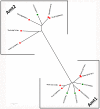Medicago truncatula transporter database: a comprehensive database resource for M. truncatula transporters
- PMID: 22309450
- PMCID: PMC3298476
- DOI: 10.1186/1471-2164-13-60
Medicago truncatula transporter database: a comprehensive database resource for M. truncatula transporters
Abstract
Background: Medicago truncatula has been chosen as a model species for genomic studies. It is closely related to an important legume, alfalfa. Transporters are a large group of membrane-spanning proteins. They deliver essential nutrients, eject waste products, and assist the cell in sensing environmental conditions by forming a complex system of pumps and channels. Although studies have effectively characterized individual M. truncatula transporters in several databases, until now there has been no available systematic database that includes all transporters in M. truncatula.
Description: The M. truncatula transporter database (MTDB) contains comprehensive information on the transporters in M. truncatula. Based on the TransportTP method, we have presented a novel prediction pipeline. A total of 3,665 putative transporters have been annotated based on International Medicago Genome Annotated Group (IMGAG) V3.5 V3 and the M. truncatula Gene Index (MTGI) V10.0 releases and assigned to 162 families according to the transporter classification system. These families were further classified into seven types according to their transport mode and energy coupling mechanism. Extensive annotations referring to each protein were generated, including basic protein function, expressed sequence tag (EST) mapping, genome locus, three-dimensional template prediction, transmembrane segment, and domain annotation. A chromosome distribution map and text-based Basic Local Alignment Search Tools were also created. In addition, we have provided a way to explore the expression of putative M. truncatula transporter genes under stress treatments.
Conclusions: In summary, the MTDB enables the exploration and comparative analysis of putative transporters in M. truncatula. A user-friendly web interface and regular updates make MTDB valuable to researchers in related fields. The MTDB is freely available now to all users at http://bioinformatics.cau.edu.cn/MtTransporter/.
Figures




References
-
- David G, Barker SB, Blondon Franqois, Yvette, Dattée GD, Essad Sadi, Flament Pascal, Philippe, Gallusci GG, Guy Pierre, Muel Xavier, Jacques, Tourneur JDaTH. Medicago truncatula, a model plant for studying the molecular genetics of the Rhizobium-legume symbiosis. Plant Molecular Biology Reporter. 1990;8:40–49. doi: 10.1007/BF02668879. - DOI
Publication types
MeSH terms
Substances
LinkOut - more resources
Full Text Sources
Research Materials

